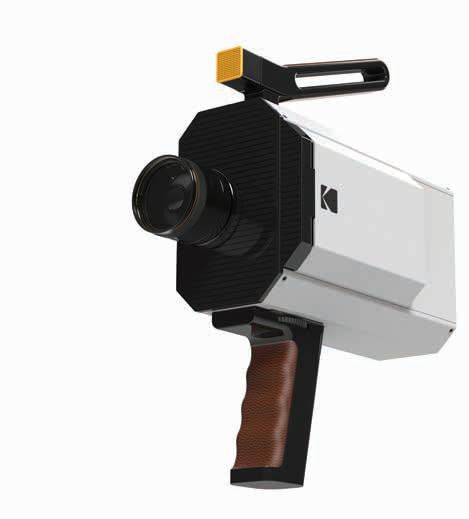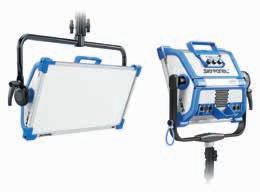
6 minute read
Tech Column
Kodak Goes Back To the Future of Super 8 Film
What was it Marshall McLuhan said about the Four Laws of Media and obsolescence? Here’s your assignment: Google them and place them into the frame while considering Eastman Kodak’s new Super 8 camera and infrastructure announced at the Consumer Electronics Show (CES) in January. Yep, Super 8 film. Old school. Film in plastic cassettes. Buy, shoot, ship them back to Kodak and you get a link to a digital copy and the processed film ready to edit on screen or on an analogue editing console. Cut, print, project. Kodak calls it the Super 8 Revival Initiative, sub-texting it as the “analogue renaissance,” and it is nostalgic. What was obsolete is now reborn again, though Super 8 has always been available along with 16 mm, 35 mm and 70 mm, as, all those Oscar nominees will attest. It just hasn’t been this accessible. Talk about irony. If there was ever a digital revolution case study, it’s Kodak Eastman where in 1975 engineer Steve Sasson presented his invention of a digital camera to his bosses and was told to stop wasting his time. “Kodak is a film company,” he was told, and we know the rest. Like so many titans of the industry, it was brought to its knees by the digital age. George Eastman may have founded his empire on film in 1888, but the magic wasn’t in the celluloid, it was in the infrastructure. Eastman sold cheap cameras to the masses and raked it in when they bought the proprietary film and other consumables to develop their footage. Kodak later pioneered the concept of film in cassettes to make them
light, safe and easy to handle, introducing the Instamatic point-and-shoot and in 1965 the S8 camera. They all followed the formula: cheap, affordable cameras for families and mail-in processing. Of course, you’d need to buy all the accessories, the projector, the screen, maybe an editing console. Kodak targeted the booming middle classes looking for a hobby just as George Eastman did initially.
Dianne Ouellette R egina-based independent filmmaker Dianne Ouellette doesn’t need to get reacquainted with the in January where the final 15 films were screened. She picked up a Kodak PixPro SP360 Action Camera, three make. “I’ve been shooting with Super 8, even 16 mm and even a Barbie VHS,” laughed Ouelette who works into the camera with a shot list, no retakes, nothing. Just straight. I even shot animals and it worked out!” magic of Super 8 movies, Pro8mm Super 8 film kits, at the University of Regina in She shot on colour reversal she’s still shooting. and a KODAK t-shirt. the Media, Arts Performance from old stock, since Ouelette landed an Her film, a three-minute program in a support role. “I Kodak only sells negative impressive third place out single take, one-spool S8 get my stuff from garage sales. these days, and sent the of 530 entries in the Super look at her dying mother You’re drooling over a Super cartridge off as an entry, 8 Filmmaking Challenge entitled Red is Dead, isn’t a 8 camera and someone just sight unseen. The soundtrack at the Slamdance Film happy film, she said, but was says, ‘Take it, take it.’ With was pieced together later. Festival at Park City, Utah, something she wanted to Red is Dead, I shot straight Entries came from around the
By 1973 they introduced a version with sound-on-film but phased it out in 1997, claiming the process to bind the oxide to the celluloid was environmentally toxic. And here we are in 2016. What’s old is new again and Eastman’s marketing formula is back. While S8 stock never disappeared, there have been no new cameras, though in 2014 Danish manufacturer Logmar launched an S8 camera to enthusiasts’ delight. Kodak must have noticed because CEO Jeff Clarke was pitching the Kodak S8 camera and film system at CES, saying it is aimed at students, experimental cinematographers and pros who want film at a lower and hasslefree entry point than 16 mm. “It is an ecosystem for film,” Clarke said in several interviews at CES. The camera is still in beta form, but it’s nothing like your granddad’s Super 8, blending digital technology like a 3.5-inch LCD viewfinder with a formfollows-function, clean white box. Industrial designer Yves Béhar, founder of Fuseproject, is on board to create the cohesive look through the lineup. It also records from a plug-in microphone to an SD card in an onboard slot. For glass there is a C-mount, fixed 6 mm, 1:1.2 Ricoh lens with manual iris and focus control. An optional 6 – 48 mm zoom is planned. Inside the camera spools 50ft Kodak Super 8 cartridges at 9, 12, 18, 24, 25 fps – at 24
Dianne Ouellette world – narrative, music videos, experimental, classic surf and skate, documentaries, archival, fashion, and home movies. She also got a hands-on with the new S8 camera and gives it a thumbs-up. “I would liked to have seen a viewfinder (instead of an LCD screen), but it has a pistol grip and seems pretty good so I’m looking forward to seeing it for sale,” she said. fps that’s about 2.5 minutes of capture. Kodak’s Nick Rangel notes things are still being worked out, so details are sketchy, but the camera will shoot the same S8 mm Kodak has made since 1965 and will be compatible with any existing accessories, so start digging around your parents’ basements. “We are in the early stages of setting up a worldwide procedure with different service levels, where every customer can choose their desired workflow,” he said. “Depending on the customer, the range will be from film processing only, up to a full service, where the customer will get the film processed, printed, digitized and sent back. Depending on the level of service, the price per cartridge will vary.” At some point, Kodak also plans to produce, package and sell developing chemicals for those hardcore enthusiasts who want to soup their own footage. Initial pricing is projected at between US$400 to US$750, according to the Wall Street Journal, with the first units arriving this fall. A cheaper consumer version is expected for 2017. Kodak’s current S8 film stock – before processing – runs at about US$30 for 50 feet and comes in four flavours, 50D/7203, 200T/7213, 500T/7219, all colour negative and Tri-X, a blackand-white reversal. All have benefited from advances in film with fine grain and sensitivity. There are other makers of S8 who cut down 35 mm stock and re-perforate as well, and any S8 stock will work on the camera and accessories but you’ll be on your own for digitizing. With pricing, the new line will cost about US$50 to US$75 for a 50-foot cartridge. For those who believe in the romanticism of film and the unique look it brings to storytelling, this could be a whole new chapter in cinematography.
Ian Harvey is a Toronto-based journalist who writes for a va riety of publications and covers the technology sector. He welcomes feedback and eagerly solicits ideas at ian@pitbullmedia.ca
LEDs from A(rri) to Z(ylight)
Upgrading to LED lighting? Check out these exciting new additions to Vistek’s incredible range of LED lighting.
NEW
Pre-Order Shipping in April

Kino Flo Select 30/20 DMX System
Super slim, the Select DMX is perfect for use in studio or on location. One of its many unique design features is the twist-on removable Centre Mount. When it’s on, the fixture mounts easily to a light stand; when it’s off, the fixture is flat and can be hand-held, or hidden in a space too small to place a stand-mounting fixture. Also features dial-in variable colour temperature control, full-range dimming and programmable 2700K to 6500K presets.
ARRI SkyPanel S60/S30

One of the brightest soft lights on the market, the SkyPanel’s light wraps around objects, eliminating sharp shadows. And with its extraordinary colour temperature range of 2,800 K – 10,000 K the SkyPanel can be used for setting the mood of a scene, or creating a perfect green to wash a greenscreen. Compact, and fully tuneable, the SkyPanel delivers light of unsurpassed power and quality for which Arri is known.





